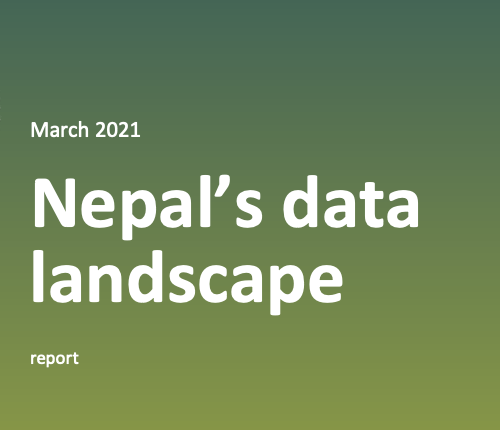
Nepal’s data landscape
March 23, 2021
Keeping Girls in STEAM to Become Women in Data
April 2, 2021Towards federal statistics: Meeting the data needs of Nepal’s new constitution
DI, in partnership with The Asia Foundation, recently completed a data landscaping study in Nepal. Its findings and recommendations have been published here. This blog summarises some of those findings.
In 2015, Nepal adopted a new constitution that aspires to extend democracy and self-government to every village in the country. The administration of the country was previously managed through 77 districts, which are now being replaced with 753 local governments indirectly managed by seven provinces. This change reflects the strong desire for locally elected officials to manage their own affairs, but such a sweeping change comes with many administrative challenges – in particular, the need for local governments to collect and manage data to produce evidence that informs the many responsibilities assigned to them in the constitution and the new Local Government Operations Act.
Of the 753 new local authorities, 17 are metropolitan or sub-metro cities and 276 are urban municipalities. These structures are relatively well equipped to manage their new responsibilities. However, 80% of the population live within the 460 rural municipalities that cover much of Nepal’s hilly, mountainous and often remote terrain. For the constitution to meet its aspirations, these rural municipalities will have to deliver.
Many of the core systems that local governments need are well established in Nepal. Over 90% of primary healthcare facilities feed data into the Health Management Information System. The Education Management Information System has similar coverage of primary schools. Public Financial Management systems exist for the management and accountability of central funding for local government, and the forthcoming 2021 census is on course to deliver an important baseline from which constitutional change can be both planned and monitored.
The problem is that there is no established practice for the data to be used at a local level. Furthermore, these systems are currently managed and supported from district offices, which are earmarked for redundancy. Provincial government is in its infancy and currently lacks the capacity to take over the downward focused technical and management responsibilities of the districts.
Rural municipalities face a number of challenges: the bureaucracies that are needed to support and implement local decision-making lack experienced administrators; the financial and technical resources required to establish and maintain the necessary ICT infrastructures are stretched; and what little data collection already exists is done for the purpose of upward reporting rather than local use.
At a national level, the government has relied on the Central Bureau of Statistics (CBS) to provide evidence for national development planning and global Sustainable Development Goals (SDG) reporting. For this the CBS has relied primarily (as do most national statistics offices in low- and middle-income countries) on household and other small sample surveys that cannot be disaggregated below district level and thus are of little use for municipal planning or monitoring.
The new National Strategy for the Development of Statistics recognises the importance of administrative data, but fails to provide a practical roadmap geared to empowering local governments to make best use of such systems. Furthermore, the CBS lacks the political authority to oversee and develop government-wide standards for the consolidation of administrative systems.
The scale of these challenges requires a new approach to the development of national data infrastructures and the production of statistics that are of use not only to the federal and provincial spheres, but to local government as well. What is needed is a federal statistical system that respects the aspirations of the constitution and meets the needs of all planners and decision-makers.
A pragmatic approach to bridging these needs and spreading the burden could be a federal statistical system consisting of three layers:
- A core consisting of the systems critical to the integrated functioning of all spheres of government, whose use is mandatory.
- A federal layer, built on surveys and administrative systems used at national and provincial level, which can meet many national planning needs and global reporting commitments.
- A local layer, where local government collects and processes data for its own use, sharing only those indicators of relevance to the monitoring of national and global development plans.
The overriding priority will, however, still be the strengthening of technical and human capacity at the local level. A three-pronged approach could build the foundations for sustainable local infrastructures.
Firstly, a cross-sectoral campaign geared to building a culture of data use, recognising the importance of evidence-informed decision-making, improving data literacy in general and stimulating data demand, would increase the possibility of a common approach being adopted across government.
Secondly, rather than operating in sectoral silos, each local government could employ an IT officer whose job would be to maintain the ICT infrastructure for all departments. They could be responsible for the technical maintenance of all information systems used, but not for the content, which should be the responsibility of departmental subject matter experts.
Thirdly, local government officials responsible for public financial management, civil registration, health, education, disaster risk management and the like should be trained and empowered to be responsible for the content – both collection and use – of their respective information systems.
Up until 2015, the sub-national management of the national statistical system relied on district statisticians and line ministry district offices managing the core administrative systems. The continued existence of these infrastructures poses a paradox. On the one hand, given that the constitution has abolished district government, they are seen to be an attempt by central government to undermine local autonomy. On the other, from a purely technical point of view, national data infrastructures depend on them.
Under the constitution, district assemblies, each supported by a district coordination committee, are bottom-up, representative institutions empowered to coordinate municipalities within each geographic district. It should therefore be possible, and constitutionally acceptable, to repurpose the technical resources currently deployed at district level to support both the district assemblies and their local government constituents.
Nepal’s ambitious constitution reflects the democratic aspirations of all its people and the institutions that serve them. The path towards a federal statistical system is thus not primarily a technological challenge, but one of institutional development implemented through a joined-up all-of-government approach led by a suitably empowered national statistics office.




